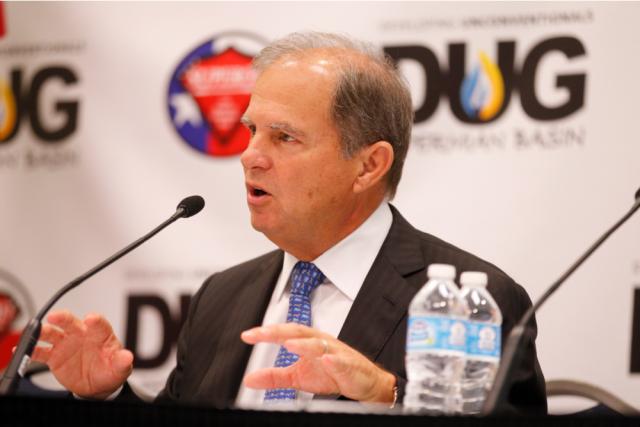
Pioneer Natural Resources, led by CEO Scott Sheffield, is the Permian Basin’s biggest single oil producer with output of almost 360,000 bbl/d. (Source: Image of Scott Sheffield at a previous DUG Permian Basin conference by Tom Fox / Hart Energy)
U.S. oil producers are not able to increase supply to tame soaring crude prices that remain “under OPEC control”, according to the shale patch’s biggest operator.
Brent crude jumped to a three-year price high above $80/bbl last week, sparking fears of a deepening global energy crunch that has already pushed natural gas and coal prices in Europe and Asia to record highs.
But Scott Sheffield, CEO of Texas-based Pioneer Natural Resources, said America’s once-prolific shale producers would keep using their burgeoning cash piles to pay shareholders, not fund new drilling.
“Everybody’s going to be disciplined, regardless whether it’s $75 Brent, $80 Brent, or $100 Brent,” Sheffield said. “All the shareholders that I’ve talked to said that if anybody goes back to growth, they will punish those companies.”
“I don’t think the world can rely much on US shale,” he said. “It’s really under OPEC control.”
Pioneer bought two rival Texas producers this year, making it the prolific Permian Basin’s biggest single oil producer with output of almost 360,000 bbl/d—more than some of the smaller member countries of the OPEC oil cartel. It has said it will cap any output increase next year at 5 per cent, well beneath the double-digit rates of previous years.
Sheffield’s comments come as the U.S. government puts pressure on Saudi Arabia, OPEC’s de facto leader, to increase crude supply to keep further energy price inflation in check.
The expanded OPEC+ alliance, which also includes allies such as Russia, will meet on Oct. 4 to decide whether to maintain output targets.
The group last year agreed deep production cuts to restore crude prices that plunged as pandemic lockdowns hit energy consumption.
But supplies are now short of demand as economies recover, with global crude stockpiles shrinking at a record pace, according to Goldman Sachs. Last week the bank raised its end-of-year Brent forecast from $80/bbl to $90/bbl. On Oct. 1, Brent settled at $79.28.
Some analysts say that the gas crunch hitting Europe and Asia could spill into markets for liquid fuels, pushing up demand for crude this winter as industries burn more oil to generate electricity.
OPEC+ agreed in July to add back 400,000 bbl/d each month until the end of 2022, but some analysts say that supplies must rise more quickly to staunch further price inflation.
U.S. national security adviser Jake Sullivan discussed oil prices with Mohammed bin Salman, Saudi Arabia’s crown prince, last week, according to the White House.
Sheffield said that while the Biden administration was calling on OPEC to increase supplies, it was trying “to slow down U.S. drilling in any way they can” through moves such as a moratorium on leasing federal lands for drilling.
“They’d rather import crude oil from OPEC,” he said.
Soaring shale production in the past decade made the U.S. the world’s biggest crude producer, pumping almost 13 million bbl/d of crude in late 2019.
But years of debt-fuelled drilling exhausted some fields, say operators, and angered investors, leaving the sector vulnerable when the pandemic struck in 2020. The price collapse forced producers to slash capital spending and idle rigs.
Drilling activity has begun to pick up—leading some analysts to predict modestly increasing output—but production remains almost 15% below the pre-pandemic peak.
Sheffield said the dealmaking in the Permian would also temper producers’ responses to rising prices.
“There’s only four or five companies that have core [acreage],” and shale would never again hit the annual growth of around 1.5 million bbl/d seen in previous years, he said.
“Maybe a million, at top, for a couple of years,” Sheffield said.
Recommended Reading
Deep Well Services, CNX Launch JV AutoSep Technologies
2024-04-25 - AutoSep Technologies, a joint venture between Deep Well Services and CNX Resources, will provide automated conventional flowback operations to the oil and gas industry.
EQT Sees Clear Path to $5B in Potential Divestments
2024-04-24 - EQT Corp. executives said that an April deal with Equinor has been a catalyst for talks with potential buyers as the company looks to shed debt for its Equitrans Midstream acquisition.
TotalEnergies, Vanguard Renewables Form RNG JV in US
2024-04-24 - Total Energies and Vanguard Renewable’s equally owned joint venture initially aims to advance 10 RNG projects into construction during the next 12 months.
Ithaca Energy to Buy Eni's UK Assets in $938MM North Sea Deal
2024-04-23 - Eni, one of Italy's biggest energy companies, will transfer its U.K. business in exchange for 38.5% of Ithaca's share capital, while the existing Ithaca Energy shareholders will own the remaining 61.5% of the combined group.
Weyerhaeuser, Lapis Energy Enter Carbon Sequestration Exploration Pact
2024-02-29 - The exploration agreement covers 187,500 acres across three states with five potential carbon sequestration sites.




